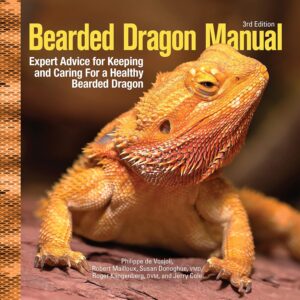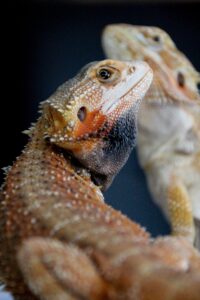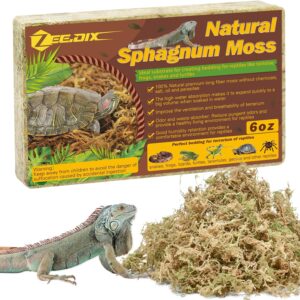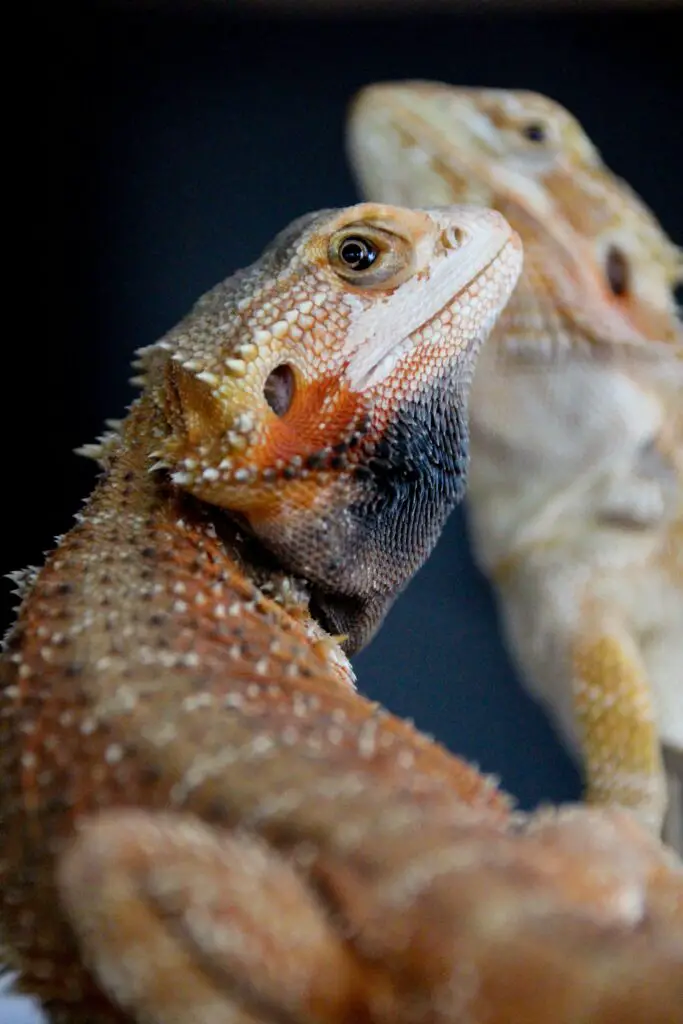Bearded dragon basking temp
Bearded dragon basking temp: A bearded dragon, scientifically known as Pogona vitticeps, is a species of lizard native to the arid regions of Australia. These reptiles have gained popularity as pets due to their docile nature, unique appearance, and relative ease of care. Bearded dragons are diurnal creatures that require both heat and light to thrive.
Definition of a bearded dragon
A bearded dragon is a medium-sized lizard characterized by its triangular-shaped head and spiky beard-like scales under its chin. They can grow up to 24 inches in length from head to tail.
Their rough skin is usually brown or gray, with patterns that help them blend into their natural environment. Bearded dragons are known for their calm temperament and sociable behavior when properly handled and cared for.
Importance of providing proper basking temperature for bearded dragons
 One crucial aspect of bearded dragon care is ensuring they have access to an appropriate basking temperature in their enclosure. Basking refers to the behavior where these lizards raise their body temperature by positioning themselves under a direct source of heat or light. This behavior is not just for comfort; it plays a vital role in their overall health and wellbeing.
One crucial aspect of bearded dragon care is ensuring they have access to an appropriate basking temperature in their enclosure. Basking refers to the behavior where these lizards raise their body temperature by positioning themselves under a direct source of heat or light. This behavior is not just for comfort; it plays a vital role in their overall health and wellbeing.
The primary reason why providing proper basking temperatures is essential for bearded dragons is that it facilitates their thermoregulation process. In the wild, these reptiles rely on external heat sources like the sun to regulate their body temperature effectively.
By strategically positioning themselves under the sun’s rays or other heat sources, they can reach optimal internal body temperatures necessary for various physiological functions. Beyond thermoregulation, maintaining appropriate basking temperatures also directly impacts digestion and metabolism in bearded dragons.
These reptiles are ectothermic animals, meaning they rely on external heat sources to raise their body temperature and facilitate proper digestion. Insufficient basking temperatures can lead to digestive issues, including poor appetite, indigestion, and even metabolic disorders.
Understanding the natural habitat of bearded dragons
Native regions and climate conditions
Bearded dragons, scientifically known as Pogona, are native to the arid and semi-arid regions of Australia. These reptiles can be found in various parts of the continent, including deserts, woodlands, and scrublands.
The diversity of their natural habitats is reflected in their adaptability to different climate conditions. Bearded dragons primarily inhabit the central and western regions of Australia, where temperatures can reach extreme highs during the day and drop significantly at night.
Relationship between basking and thermoregulation in the wild
In their natural habitat, bearded dragons have perfected the art of thermoregulation to maintain optimal body temperature for various physiological functions. Basking plays a crucial role in this process. The reptiles position themselves under direct sunlight or on warm surfaces to absorb heat energy required for metabolism and other bodily processes.
When a bearded dragon basks under the sun or on heated rocks, its body temperature elevates beyond normal levels. This increased core temperature aids digestion by enhancing enzyme activity within its gut.
Furthermore, it facilitates nutrient absorption from food sources such as insects and vegetation. Basking also supports overall energy management for these cold-blooded creatures.
By exposing themselves to heat sources when needed, they optimize metabolic processes that allow them to remain active during daytime while conserving energy during cooler periods. In addition to aiding digestion and energy regulation, basking helps strengthen immune function in bearded dragons due to an increase in blood circulation throughout their bodies.
This enhanced circulation assists white blood cells in reaching areas where they are needed most effectively. Understanding these fundamental aspects of a bearded dragon’s natural habitat provides valuable insight into why maintaining an appropriate basking temperature is crucial for their health and well-being when kept as pets.
The Role of Basking Temperature for Bearded Dragons
Essential for Digestion and Metabolism
The basking temperature plays a crucial role in the digestion and metabolism of bearded dragons. These fascinating reptiles are ectothermic, meaning they rely on external sources of heat to regulate their body temperature. When a bearded dragon basks under a heat source, such as a heat lamp or heat mat, it absorbs warmth that allows its digestive system to function optimally.
The elevated temperature stimulates the production of digestive enzymes, facilitating the breakdown and absorption of nutrients from their food. Inadequate basking temperatures can lead to poor digestion and nutrient absorption in bearded dragons.
When the ambient temperature is too low, their metabolism slows down, resulting in incomplete digestion and potential health issues like constipation or malnutrition. It is crucial for bearded dragon owners to provide a suitable basking spot that reaches the recommended temperature range to ensure efficient digestion and maximize nutrient utilization.
Promotes Healthy Growth and Development
Proper basking temperatures are not only essential for digestion but also play a vital role in promoting healthy growth and development in bearded dragons. These reptiles require warmth to support metabolic processes that enable growth at different stages of their lives. Adequate exposure to appropriate temperatures during basking periods ensures efficient utilization of energy derived from their diet, which is then utilized for growth and tissue repair.
Insufficient warming can hinder the growth rate of bearded dragons, leading to stunted growth or developmental abnormalities. Regular access to an appropriately heated basking area helps maintain an accelerated metabolic rate required for growth, ensuring these reptiles reach their full potential size while developing properly proportioned body structures.
Supports Immune System Function
 Maintaining optimal basking temperatures also plays a vital role in supporting the immune system function of bearded dragons. Like all living organisms, bearded dragons are susceptible to various diseases and infections.
Maintaining optimal basking temperatures also plays a vital role in supporting the immune system function of bearded dragons. Like all living organisms, bearded dragons are susceptible to various diseases and infections.
A properly functioning immune system is crucial for their overall health and the ability to fight off pathogens effectively. Basking under suitable temperatures enhances the immune response in bearded dragons.
When provided with an adequately warmed environment, their bodies can allocate resources towards bolstering their immune defenses rather than diverting energy towards maintaining body temperature. The optimal basking temperature range allows the reptile’s metabolic functions to operate efficiently, supporting the production of antibodies and strengthening their resistance against potential illnesses.
The basking temperature is of paramount importance for bearded dragons’ well-being. It supports essential processes like digestion and metabolism by aiding nutrient absorption and facilitating enzyme activity.
Additionally, appropriate basking temperatures help promote healthy growth and development in these reptiles, ensuring they reach their full potential size while avoiding growth-related issues. Maintaining optimal basking temperatures supports a strong immune system that aids in fighting off infections and promoting overall health in these remarkable creatures.
Optimal Basking Temperature Range for Bearded Dragons
The basking temperature is a crucial aspect of bearded dragon husbandry, as it directly influences their health and well-being. The general range for optimal basking temperature falls between 95°F to 105°F (35°C to 40°C).
This range mimics the warmth found in their natural habitat and supports various physiological processes necessary for their overall vitality. Bearded dragons are ectothermic reptiles, meaning they rely on external sources of heat to regulate their body temperature.
By providing a basking spot within this appropriate range, you allow them to thermoregulate effectively. The higher end of the range, around 105°F (40°C), offers an ideal temperature for digestion and metabolism, while the lower end, around 95°F (35°C), provides a comfortable retreat from excessive heat.
Importance of Providing a Gradient Within This Range
Bearded dragon basking temp: Creating a gradient within the optimal basking temperature range is imperative to accommodate individual needs and preferences. Bearded dragons should have access to both hotter and cooler areas within their enclosure so they can self-regulate their body temperature as needed.
This gradient allows them to move freely between warmer spots where they can absorb more heat energy and cooler areas where they can escape from excessive warmth. The availability of different temperatures also helps bearded dragons fulfill specific physiological requirements at different stages of their lives or during various activities.
For instance, juveniles may require slightly higher temperatures for optimal growth compared to adults. Additionally, gravid females (those carrying eggs) may need higher temperatures during egg development.

Factors Influencing Specific Temperature Requirements
While the recommended general range provides guidance, it’s essential to consider several factors when determining specific temperature requirements for your bearded dragon:
Age: Younger bearded dragons may need slightly higher temperatures, gradually lowering as they mature.
Activity level: More active dragons may require slightly higher basking temperatures to support their metabolism and energy needs.
Health condition: Sick or injured bearded dragons might benefit from a slightly warmer basking spot to aid in their recovery process.
Tail position: The position of the tail can indicate a dragon’s comfort level. A raised tail suggests they are trying to cool down, while a lowered tail indicates an effort to absorb more heat.</li><p></p>
By taking these factors into account, you can fine-tune the basking temperature within the recommended range and provide your bearded dragon with an optimal thermal environment for overall health and happiness.
Factors Affecting Basking Temperature Regulation in Captivity
Types of Heat Sources Commonly Used in Reptile Enclosures
Bearded dragon basking temp: When it comes to providing the essential basking temperature for your beloved bearded dragon, there are several common types of heat sources that can be utilized within reptile enclosures. Each option has its own unique set of characteristics and considerations to take into account.
Incandescent Bulbs:
Incandescent bulbs are a popular choice among reptile enthusiasts for providing heat in the basking area. These bulbs emit light and heat, creating a warm spot for your bearded dragon to soak up those vital rays.
The advantage of incandescent bulbs is their affordability and accessibility, as they can be easily found in most hardware stores. However, it’s important to note that these bulbs consume more energy compared to other options and have a shorter lifespan.
Ceramic Heat Emitters:
Ceramic heat emitters (CHEs) offer an effective means of providing focused warmth without emitting light, which is ideal for nocturnal reptiles like bearded dragons who require darkness during their sleep cycle. These emitters generate heat through infrared radiation, making them energy-efficient options that won’t disrupt your pet’s natural lighting patterns. One drawback of CHEs is that they tend to be more expensive upfront compared to incandescent bulbs.
Heat Mats:
Heat mats, also known as under-tank heaters or UTHs, are another viable choice for achieving adequate basking temperatures. These flat heating pads adhere beneath the enclosure and radiate gentle heat from below, simulating the warmth of sun-baked surfaces in nature.
Heat mats provide a consistent source of low-level warmth but lack the ability to create a focused basking spot like bulbs or emitters do. They are particularly useful when combined with other heat sources to create a thermal gradient within the enclosure.
Pros and Cons of Each Option
Incandescent Bulbs:
– Pros: Affordable, easily accessible, provide both heat and light, can be used in combination with UVB bulbs.
– Cons: High energy consumption, shorter lifespan compared to other options.
Ceramic Heat Emitters:
– Pros: Emit focused heat without light, energy-efficient, suitable for nocturnal reptiles.
– Cons: Higher upfront cost compared to incandescent bulbs.
Heat Mats:
– Pros: Offer gentle and consistent warmth from below, useful for creating a thermal gradient.
– Cons: Do not provide a concentrated basking spot like bulbs or emitters. Considering the unique needs and preferences of your bearded dragon, it is important to choose the heat source that best suits their requirements.
Keep in mind factors such as enclosure size, ambient temperature, and the specific heating needs of your pet when making this decision. Whatever option you choose, ensuring proper regulation of basking temperature is vital for the well-being and overall health of your scaly companion.
Monitoring and Maintaining the Basking Temperature
Thermometers: Essential Tools for Accurate Measurement
Sustaining an optimal basking temperature for your bearded dragon requires precise monitoring, and this is where thermometers become invaluable. Thermometers are indispensable tools that enable you to monitor the temperature of your reptile’s enclosure with accuracy and ensure their well-being. There are two main types of thermometers commonly used: digital thermometers and analog thermometers, each with their own set of advantages and considerations.
Digital Thermometers vs Analog Thermometers
Digital thermometers have gained popularity in recent years due to their convenience and accuracy. These electronic devices typically come with a probe that can be placed directly in the basking area or attached to a designated spot within the enclosure.
The digital display provides a clear reading of the exact temperature, allowing you to make adjustments as needed. Digital thermometers often offer additional features like minimum and maximum temperature recordings, making it easier to track fluctuations over time.
On the other hand, analog thermometers have been a reliable choice for many reptile keepers over the years. They consist of a simple glass tube filled with mercury or alcohol that expands or contracts based on temperature changes.
The readings on analog thermometers are displayed via a needle on a scale dial. While analog models may lack some of the advanced features found in digital counterparts, they still provide accurate measurements when properly calibrated.
Bearded dragon basking temp: Accuracy, Reliability, and Ease of Use
 Digital thermometers usually offer higher accuracy levels compared to analog ones. They often provide temperature readings down to decimals, allowing for more precise adjustments in your bearded dragon’s environment. However, it is essential to remember that even slight variations in placement or calibration can affect accuracy.
Digital thermometers usually offer higher accuracy levels compared to analog ones. They often provide temperature readings down to decimals, allowing for more precise adjustments in your bearded dragon’s environment. However, it is essential to remember that even slight variations in placement or calibration can affect accuracy.
Analog thermometers rely on tried-and-true technology and can also give accurate readings if appropriately calibrated. However, their accuracy may not match that of digital thermometers, particularly when dealing with narrow temperature ranges.
It is crucial to periodically check and calibrate analog thermometers to ensure accurate and reliable measurements. Both types of thermometers are relatively easy to use, but digital thermometers may offer added convenience with their instant display and additional features like alarms for high or low temperatures.
Analog thermometers require a quick glance at the needle on the dial but lack these supplementary functions. Ultimately, the choice between digital and analog thermometers will depend on your personal preferences and budget.
Placement Considerations within the Enclosure
Regardless of which type of thermometer you choose, proper placement is vital for obtaining accurate temperature readings in your bearded dragon’s enclosure. The thermometer should be positioned at the same height as your reptile’s basking spot, as this is where temperature matters most for their well-being.
For digital thermometers with a probe, ensure that it is securely fastened in a representative area without obstructing your bearded dragon’s movement or causing any harm. This might involve using adhesive hooks or clips to secure the probe in place.
Analog thermometers need to be placed inside the enclosure near your reptile’s basking area while ensuring they are not exposed to excessive heat directly from heat sources like lamps or heaters. Additionally, avoid placing them where they may obstruct proper airflow within the enclosure.
By selecting an appropriate thermometer type and carefully positioning it within the enclosure, you can effectively monitor and maintain an optimal basking temperature for your beloved bearded dragon. Accurate measurements will help provide a comfortable environment that promotes their overall health and well-being.
Tips for creating an ideal basking spot
Providing adequate UVB lighting alongside heat source
Bearded dragon basking temp: Bearded dragons require not only a proper basking temperature but also access to appropriate UVB lighting. UVB rays play a vital role in the synthesis of vitamin D3, which is crucial for calcium metabolism in bearded dragons. Without adequate UVB exposure, these reptiles can develop serious health issues like metabolic bone disease.
Therefore, it is essential to invest in high-quality UVB bulbs specifically designed for reptiles. Fluorescent tube bulbs are commonly recommended as they provide a broader and more consistent output of UVB rays.
Importance of UVB rays for calcium metabolism
UVB rays stimulate the production of vitamin D3 in the skin, which allows bearded dragons to efficiently absorb and utilize dietary calcium. Calcium is necessary for strong bone development and overall skeletal health.
Without sufficient levels of calcium, bearded dragons can suffer from weakened bones, fractures, muscle twitching, or even paralysis. Providing adequate UVB lighting supports healthy calcium metabolism and prevents these debilitating conditions.
Choosing appropriate UVB bulbs based on their output
When selecting a UVB bulb for your bearded dragon’s enclosure, it is crucial to consider the bulb’s output measured in terms of its strength or intensity. The appropriate level of UVB output required depends on factors such as the size of the enclosure and distance between the bulb and basking spot.
For most standard enclosures, a 10% to 12% UVB bulb should suffice. However, if you have an exceptionally large enclosure or need to mount the bulb further away from the basking spot due to heat concerns, you may opt for a higher-output bulb.
Creating a comfortable platform or perch area
Bearded dragon basking temp: To facilitate proper basking behavior, it is important to provide your bearded dragon with a comfortable platform or perch area within their enclosure. Natural materials such as rocks or branches serve as ideal options for creating these basking spots. These materials not only offer a stable and secure surface for your dragon to rest on but also provide texture and variation in height, mimicking the natural environment.
Including multiple basking spots at different heights allows your bearded dragon to choose the one that suits their preference and temperature requirements. Make sure to select items that are sturdy enough to support the weight of your reptile and free from sharp edges that may cause injury.
Additionally, regular cleaning and sanitizing of these surfaces are essential to maintain hygiene within the enclosure.
To sum up bearded dragon basking temp
Ensuring an appropriate basking temperature for bearded dragons is crucial for their overall well-being. By providing both adequate UVB lighting alongside a suitable heat source, you support their calcium metabolism, skeletal health, and overall vitality.
Choosing the right UVB bulbs based on their output ensures optimal exposure while considering factors like enclosure size. Creating comfortable perch areas using natural materials adds an element of enrichment and mimics their native environment.
By implementing these tips, you can create an ideal basking spot that promotes optimum health for your bearded dragon. Remember, a happy and healthy reptile will reward you with vibrant colors, active behavior, and a strong bond between pet and owner.
Further Reading:
- Carolina Custom Cages Terrarium Review
- 8 Best Basking Rocks for Beardie: What Is the Best Choice?
- 10 Best Thermometers for Beardie: How to Choose the Best One?
- 5 Best Beardie Lighting Setups for Beardie Lovers
- 9 Best Heat Lamps for Beardie: Natural Habitat Provided



